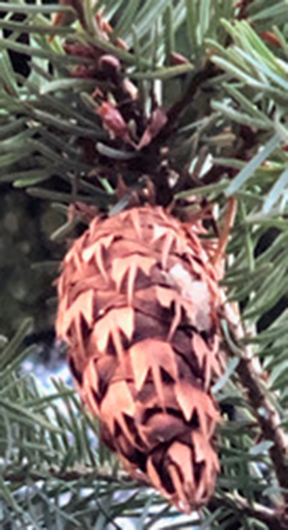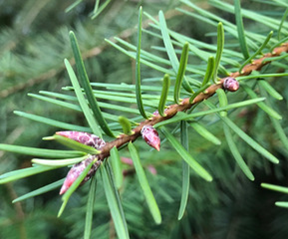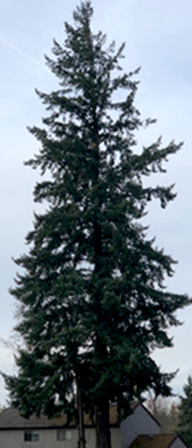Douglas firs: they’re for more than Christmas

by Susan Mates

Care to bet on the types of trees Cedar Millers are strapping to the roofs of their cars this holiday season? Chances are pretty good that they’re Douglas firs, the most popular for Christmas trees in the United States since the 1920s. They are beloved for their soft needles and sweet scent. But you don’t have to restrict your appreciation for Douglas firs to the holiday season.
Douglas fir(Pseudotsuga menziesii) is Oregon’s iconic tree, although it is not a true fir (thus the “pseudo” in its name). In fact, it’s our state tree. Botanist-explorer David Douglas—this tree’s namesake—described it as “one of the most striking and truly graceful objects in nature.” Douglas firs can grow to be 300 feet tall with diameters of more than 13 feet. They can live more than 1,500 years.
The lower branches of Douglas firs droop gracefully. They are easy to recognize by their “groovy” bark, pointed buds, and distinctive, light brown cones with three-pronged bracts. A Native American myth tells of a frightened mouse trying to escape a forest fire and finding safety in a Douglas fir cone. The story goes that the mouse’s back legs and tail are still visible sticking out beneath the cone’s scales.

Besides their use as holiday decorations, Douglas firs are critical to wildlife and to humans. Native Americans use the trees for building, basketry, and medicinal purposes. These trees also helped settle the West, providing masts for ships as well as railroad ties and telephone/telegraph poles. Today, their strong wood is used for wharves, bridge parts, building and construction.

Now, environmental scientists and architects are eyeing Douglas firs for use in cross-laminated timbers for high-rise construction to mitigate climate change. The emissions from buildings constructed from concrete and steel could reach 600 million tons a year by 2050. But construction of timber buildings could store up to 680 million tons of carbon a year.

Living Douglas firs also sequester a lot of carbon. Through photosynthesis, they transform sunlight, water, and carbon dioxide into millions of tons of biomass, about half of which is carbon. The carbon is safely stored in their wood, not warming the atmosphere. Old trees, because of their size, can hold far more carbon than younger trees. The largest 1 percent of trees contain half of all the above-ground live biomass, which also means half of all the carbon. Just one Douglas fir is expected to sequester almost 14 tons of carbon in its first 100 years.
As you go about picking your Christmas tree, be aware that Douglas firs as well as other trees for Christmas decorating are heavily sprayed with pesticides that can adversely affect you, your home and the workers who harvest them. Treekeepers encourages the selecting of trees from certified organic farms or farms that don’t use pesticides. In our area, we even have options for businesses that drop off a living tree in December and pick it up after the holidays. Then it is replanted where it can mature and sequester carbon for us.
Protecting mature trees is the mission of Treekeepers of Washington County. Contact us or visit our website to find out more.





